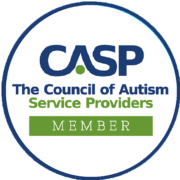Can Level 2 Autism Become Level 1?
Autism levels (Level 1, Level 2, and Level 3) are used as a framework to describe the varying support needs of learners with Autism Spectrum Disorder (ASD). Level 1 learners require some support, learners with Level 2 autism need more substantial support, and Level 3 learners need very substantial support.
These levels have no correlation with intelligence, are not fixed, and can change over time depending on the learner’s development, the interventions they receive, and environmental factors. Some learners have very few symptoms of autism, but the symptoms are more severe Other learners have a number of symptoms, but they are less severe. Support needs are individualized based on what a learner needs to help them be successful.
In this article, we’ll outline the three different levels of autism and answer some questions we’re asked at A Bridge to Achievement pretty frequently about Level 1 and Level 2 autism. Let’s get into it!
Understanding Autism Levels
The Diagnostic and Statistical Manual of Mental Disorders, Fifth Edition – known better as the DSM-5 – is a 957-page book that was published in 2013 by the American Psychiatric Association. The Neurodevelopmental Disorders chapter defines the three levels of autism as:
Level 1 Autism: Requiring Support
Learners with Level 1 have “mild symptoms” of autism and require some support in specific areas, especially with social communication and organization. In the past, Level 1 was often referred to as Asperger’s or high-functioning autism. Many adults with Level 1 autism can live independently with minimal support for social or organizational challenges.
Examples of Challenges:
- Difficulty initiating or maintaining conversations.
- Challenges with organization or planning, which may affect independence.
- Sensory sensitivities that occasionally interfere with daily activities.
- Some challenges with adjusting to change and emotional regulation.
Examples of Support Needed:
- Social skills practice to improve conversation and interaction.
- Guidance with organization or time management tasks.
- Accommodations for sensory sensitivities, such as a quiet workspace.
- Help to create structured routines and calming strategies.
Level 2: Requiring Substantial Support
Learners with Level 2 autism have more noticeable verbal and nonverbal communication differences and may struggle more significantly in social settings and with routine changes.
Some adult individuals with Level 2 autism achieve semi-independent living with substantial support, such as structured routines and regular assistance.
Examples of Challenges:
- Limited verbal communication or reliance on nonverbal methods (e.g., gestures, pictures).
- Significant difficulty coping with changes or transitions.
- Repetitive behaviors or intense focus on specific interests that interfere with learning, socializing, and daily functioning.
- Difficulty understanding or responding to social cues, leading to struggles in forming or maintaining relationships.
Examples of Support Needed:
- Speech therapy or augmentative and alternative communication (AAC) devices.
- Structured environments with clear routines and expectations.
- Social stories or visual aids to prepare for transitions and changes.
- One-on-one or small group support to facilitate social skills development.
Level 3: Requiring Very Substantial Support
Level 3 learners have severe challenges with communication, behaviors, and daily functioning. They require intensive support at all ages, making independent living unlikely for adult learners.
Examples of Challenges:
- Very limited or no verbal communication.
- Difficulty engaging with others or forming relationships.
- Extreme distress from changes in routine or environment.
- Strong sensory sensitivities that can lead to meltdowns or withdrawal from activities.
Examples of Support Needed:
- Full-time assistance for daily tasks, including personal care and communication.
- Intensive behavioral therapy to address repetitive or self-injurious behaviors.
- Specialized communication supports, such as AAC devices or intensive one-on-one interventions.
- A controlled, sensory-friendly environment to minimize triggers and promote comfort.
- Programming and/or environmental changes to keep learners safe during concerns related to self-injurious behavior, elopement, and lack of awareness of surroundings.

Can Autistic Learners Shift Between Diagnostic Levels?
One question we’re frequently asked is: Can learners shift between levels? In particular, can Level 2 autism become Level 1, and can Level 1 become Level 2 autism?
Yes, shifts between levels are observed in some learners – but not everyone experiences significant changes in their level of support needs. Progress or regression is highly individual and depends on various factors such as developmental stages, life changes, or access to (or lack of) support systems.
It’s also important to note that autism does not have a cure. Autism does not get “better” or “worse,” and you cannot grow out of autism. Autism is a lifelong neurological condition that manifests differently in every learner.
Can Level 2 Autism Become Level 1?
While every individual is different, learners with Level 2 autism have a higher likelihood to shift to a Level 1 diagnosis if they have access to:
- Therapeutic Intervention
Applied Behavior Analysis (ABA) therapy can significantly help learners develop communication, social, and adaptive skills, potentially reducing the level of support needed. Early intervention is best when possible, but ABA therapy at any age is shown to be effective. - Skill Development
With support and practice, learners may gain strategies to navigate social situations, communicate effectively, or manage sensory challenges, which can lead to more independence. - Environmental Factors
A supportive environment (at home, school, or work) tailored to the individual’s needs can also reduce the challenges they face, leading to a reevaluation of their level.
Additionally, some individuals naturally acquire skills and adapt as they grow older, reducing the perceived severity of their autism symptoms.
Can Level 1 become Level 2 Autism?
A learner’s diagnosis can shift from Level 1 to Level 2 autism if their support needs increase due to such factors as:
- Increased Stress or Life Changes
Major life transitions, such as starting school, entering the workforce, or a change in routine, can exacerbate challenges, requiring more substantial support. - Unmet Support Needs
If an individual doesn’t receive the necessary interventions or accommodations, they may struggle more significantly over time. - Co-occurring Conditions
Conditions like anxiety, depression, or sensory processing disorders can worsen and increase the individual’s overall challenges. - Developmental Changes
As demands for social, organizational, or adaptive skills grow (e.g., in adolescence or adulthood), some individuals may find it harder to cope without more support. - Burnout
Autistic burnout occurs when long-term stress leads to exhaustion, regression in skills, or difficulty functioning, often increasing the need for support.
What To Do If You Suspect A Diagnostic Shift
Autism levels are determined during diagnostic evaluations. A learner who shows significant improvement or regression in a particular area would benefit from a reevaluation by a qualified professional, i.e. a psychologist, psychiatrist, developmental pediatrician, neurologist, or other clinician. It’s possible that your learner may experience a change in their diagnosis.
If your learner shifts from Level 1 to Level 2 autism, they may benefit from increasing the intensity of ABA therapy and making environmental adjustments at school, work, or home to reduce stress and help manage symptoms. A learner who shifts from Level 2 autism to Level 1 may be able to reduce the intensity of therapeutic interventions.
Are you interested in having your learner assessed for autism, or retested? Connect with your therapy team or, if you’re new to A Bridge to Achievement, get in touch! Support starts here.






